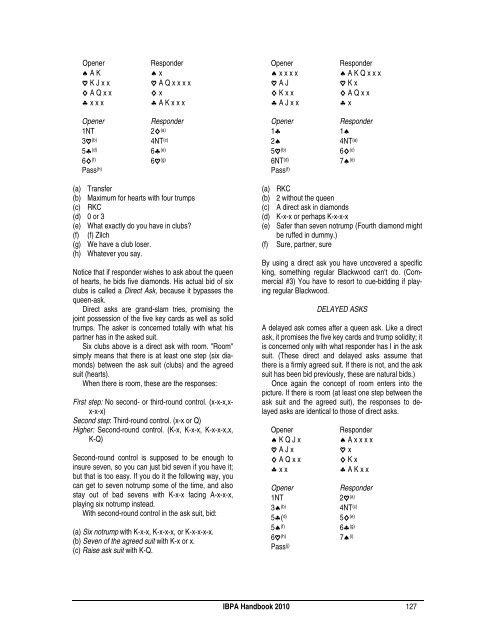Handbook - International Bridge Press Association
Handbook - International Bridge Press Association
Handbook - International Bridge Press Association
Create successful ePaper yourself
Turn your PDF publications into a flip-book with our unique Google optimized e-Paper software.
Opener Responder<br />
♠ A K ♠ x<br />
K J x x A Q x x x x<br />
A Q x x x<br />
♣ x x x ♣ A K x x x<br />
Opener Responder<br />
1NT 2 (a)<br />
3 (b) 4NT (c)<br />
5♣ (d) 6♣ (e)<br />
6 (f) 6 (g)<br />
Pass (h)<br />
(a) Transfer<br />
(b) Maximum for hearts with four trumps<br />
(c) RKC<br />
(d) 0 or 3<br />
(e) What exactly do you have in clubs?<br />
(f) (f) Zilch<br />
(g) We have a club loser.<br />
(h) Whatever you say.<br />
Notice that if responder wishes to ask about the queen<br />
of hearts, he bids five diamonds. His actual bid of six<br />
clubs is called a Direct Ask, because it bypasses the<br />
queen-ask.<br />
Direct asks are grand-slam tries, promising the<br />
joint possession of the five key cards as well as solid<br />
trumps. The asker is concerned totally with what his<br />
partner has in the asked suit.<br />
Six clubs above is a direct ask with room. "Room"<br />
simply means that there is at least one step (six diamonds)<br />
between the ask suit (clubs) and the agreed<br />
suit (hearts).<br />
When there is room, these are the responses:<br />
First step: No second- or third-round control. (x-x-x,xx-x-x)<br />
Second step: Third-round control. (x-x or Q)<br />
Higher: Second-round control. (K-x, K-x-x, K-x-x-x,x,<br />
K-Q)<br />
Second-round control is supposed to be enough to<br />
insure seven, so you can just bid seven if you have it;<br />
but that is too easy. If you do it the following way, you<br />
can get to seven notrump some of the time, and also<br />
stay out of bad sevens with K-x-x facing A-x-x-x,<br />
playing six notrump instead.<br />
With second-round control in the ask suit, bid:<br />
(a) Six notrump with K-x-x, K-x-x-x, or K-x-x-x-x.<br />
(b) Seven of the agreed suit with K-x or x.<br />
(c) Raise ask suit with K-Q.<br />
Opener Responder<br />
♠ x x x x ♠ A K Q x x x<br />
A J K x<br />
K x x A Q x x<br />
♣ A J x x ♣ x<br />
Opener Responder<br />
1♣ 1♠<br />
2♠ 4NT (a)<br />
5 (b) 6 (c)<br />
6NT (d) 7♠ (e)<br />
Pass (f)<br />
(a) RKC<br />
(b) 2 without the queen<br />
(c) A direct ask in diamonds<br />
(d) K-x-x or perhaps K-x-x-x<br />
(e) Safer than seven notrump (Fourth diamond might<br />
be ruffed in dummy.)<br />
(f) Sure, partner, sure<br />
By using a direct ask you have uncovered a specific<br />
king, something regular Blackwood can't do. (Commercial<br />
#3) You have to resort to cue-bidding if playing<br />
regular Blackwood.<br />
DELAYED ASKS<br />
A delayed ask comes after a queen ask. Like a direct<br />
ask, it promises the five key cards and trump solidity; it<br />
is concerned only with what responder has I in the ask<br />
suit. (These direct and delayed asks assume that<br />
there is a firmly agreed suit. If there is not, and the ask<br />
suit has been bid previously, these are natural bids.)<br />
Once again the concept of room enters into the<br />
picture. If there is room (at least one step between the<br />
ask suit and the agreed suit), the responses to delayed<br />
asks are identical to those of direct asks.<br />
Opener Responder<br />
♠ K Q J x ♠ A x x x x<br />
A J x x<br />
A Q x x K x<br />
♣ x x ♣ A K x x<br />
Opener Responder<br />
1NT 2 (a)<br />
3♠ (b) 4NT (c)<br />
5♣( d) 5 (e)<br />
5♠ (f) 6♣ (g)<br />
6 (h) 7♠ (i)<br />
Pass (j)<br />
IBPA <strong>Handbook</strong> 2010 127


